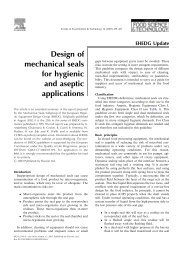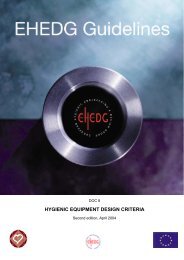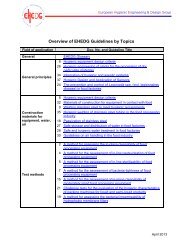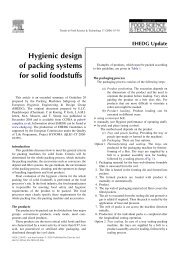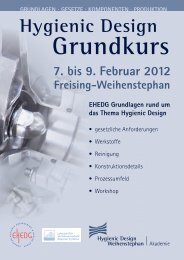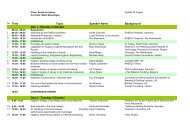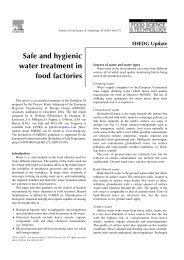Yearbook 2013/2014 - ehedg
Yearbook 2013/2014 - ehedg
Yearbook 2013/2014 - ehedg
Create successful ePaper yourself
Turn your PDF publications into a flip-book with our unique Google optimized e-Paper software.
European Hygienic Engineering & Design Group<br />
Damage scenarios for valves:<br />
Identifying the potential for optimisation<br />
Willi Wiedenmann, Krones AG, D- Neutraubling, e-mail: willi.wiedenmann@krones.com, www.krones.com<br />
Ideally, valves used in the production process would go<br />
unnoticed and remain problem-free throughout a line’s<br />
entire functional lifetime. But valve integration cannot be<br />
ignored quite so easily; after all, these components are<br />
indispensable for automated production processes to ensure<br />
the appropriate routing paths and to shut off product flows.<br />
They are required to exhibit maximum reliability in terms of<br />
design and function, and to be sturdy enough to effortlessly<br />
cope with any events occurring in the production process.<br />
Where exactly are the potential problems associated with<br />
valves? Moving parts for opening and closing the shut-off<br />
components, duty limits of seal materials as well as product<br />
characteristics, and the temperatures encountered in the<br />
production and cleaning processes all demand a lot from<br />
the components involved and influence their useful lifetimes.<br />
Then there are the imponderables, such as water hammers<br />
or human error in handling the individual components<br />
when removing and installing wear parts. By designing a<br />
radically new series of valves, Krones has taken on board<br />
the empirical feedback from operating aseptic and nonaseptic<br />
production lines, and has created a family of valves<br />
that exhibit salient improvements for many of the problems<br />
encountered in valve design. This involves valve design that<br />
contributes to safe and contamination-free product routing,<br />
and incorporates features that simplify the operator’s work<br />
and enhance personnel safety.<br />
Seal design for butterfly valves<br />
Numerous cases of damage when using valves are<br />
associated with the seal. In the case of a butterfly valve,<br />
for instance, volume changes will occur, caused by rises<br />
in temperature. These swellings on the seals protrude into<br />
the product compartment, so that during the opening and<br />
closing operations for the valve disc, the increased level<br />
of friction causes small particles to be abraded, which<br />
are then entrained in the product or the cleaning agent<br />
(Figure 1).<br />
The result is that the valve no longer closes properly, which<br />
means that the liquids are no longer dependably separated,<br />
resulting in product contamination. For example, if the flap<br />
is no longer being positioned in a 90° configuration, the<br />
feedback signal from the proximity sensor is not being sent,<br />
and the system goes into fault mode, which entails substantial<br />
costs in terms of lost production output (Figure 2).<br />
Figure 2. Swelling of the seal, with tear, in conjunction with<br />
imprecise closing of the butterfly valve.<br />
With a seal design that incorporates two expansion grooves<br />
the expansion caused by a change in temperature can be<br />
purposefully confined to the seal’s installation space in the<br />
housing, and the abrasion or damage in areas coming into<br />
contact with the product can thus be avoided (Figure 3).<br />
Figure 3. Cross-sectional view of a butterfly valve with optimum<br />
installation situation for the seal.<br />
Figure 1. Seal abrasion at the disc.<br />
And in order to prevent wear phenomena due to valve<br />
flap movements, a smooth surface has been provided in<br />
the product compartment, thus relocating the dividing line<br />
to outside the product area. A lead-in chamfer on the seal



